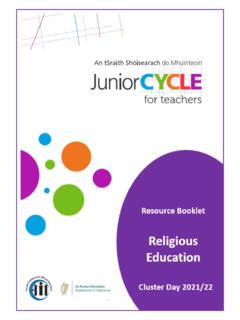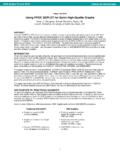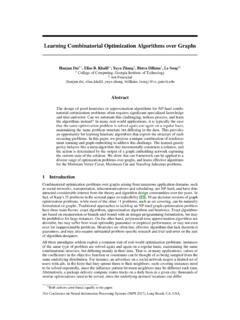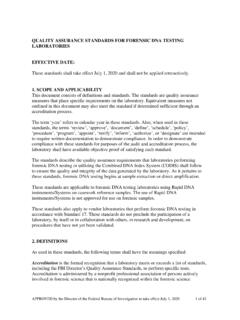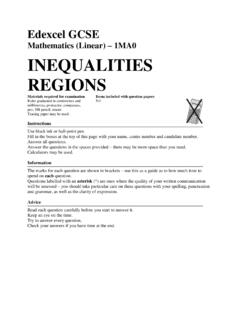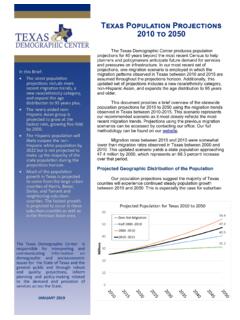Transcription of Features of Quality - SSI - JCT
1 Features of Quality - SSI Key Features of Quality in support of student and teacher judgement for the Science in Society Investigation are described here. The Features of Quality are the criteria used to assess the student work as best fitting one of the four Descriptors. Exceptional Above Expectations In Line with Expectations Yet to Meet Expectations Investigating Chooses an interesting or novel topic and research question Finds information about the topic from a large number of varied and balanced sources, and gives a complete reference list Evaluates the reliability (relevance, accuracy and bias) of the sources Chooses an interesting or novel topic and research question Finds information about the topic from a number of balanced sources, and gives a complete reference list Considers the reliability and Quality (relevance, accuracy and bias)
2 Of the sources Chooses a topic and research question with some teacher guidance Finds some useful sources of information about the topic and gives some references Gives some consideration to the reliability or Quality (relevance, accuracy and bias) of the sources Chooses a topic but is given the research question Is directed to sources of information about the topic Uses very few sources with little evidence of what the sources are Communicating Clearly positions the topic as science in society; explains the relevant science and the impact of the topic on society and/or the environment Presents the investigation in a very well-structured way (that is clear and easy to read) using relevant scientific terminology and informative representations; uses an innovative approach that truly enhances the work Explains different sides of the argument in detail Positions the topic as science in society; explains the relevant science and the impact of the topic on society and/or the environment Presents the investigation in a well-structured way (that is clear and easy to read), using relevant scientific terminology and informative representations Considers information from different sides of the argument Mentions in passing the impact of the topic on society and/or the environment.
3 Presents the investigation in a structured way using relevant scientific terminology Provides information on different sides of the argument Presents the investigation using some scientific terminology Presents the investigation in a way that is somewhat structured Knowledge & Understanding Views on the chosen topic are considered and discussed in depth Gives a justified personal opinion informed by research, linking the information to the argument and using science explanations Gives a personal opinion informed by research linking the information to the argument and using science explanations Gives a personal opinion informed by research with some explanation Gives a personal opinion without explanation or a link to the original question Adapted from Junior Cycle Science Guidelines for the Classroom-Based Assessments and Assessment Task For use with CBAs from October 2018, NCCA Features of Quality - EEI Key Features of Quality in support of student and teacher judgement for the Extended Experimental Investigation are described here.
4 The Features of Quality are the criteria used to assess the student work as best fitting one of the four Descriptors. Exceptional Above Expectations In Line with Expectations Yet to Meet Expectations Investigating Forms a testable hypothesis or prediction with justification Describes considerations related to reliability and fairness Outlines appropriate safety considerations, and describes the method used to accurately collect and record good Quality , reliable data in a manner that could be easily repeated. Uses an innovative approach that truly enhances the work Records a sufficient amount of good Quality data Forms a testable hypothesis or prediction with justification Identifies the variable to be measured and the variable to be changed Outlines appropriate safety considerations, and describes the method and equipment used to collect and record data Records a sufficient amount of good Quality data With limited guidance.
5 Forms a testable hypothesis/prediction Describes a safe method used to collect data some of the steps are understandable but lack some detail Records raw/primary data Uses a given investigation question Is directed in using equipment to collect and record data Data collection method described is not repeatable Communicating Presents data in the most appropriate way using relevant scientific terminology and informative representations; calculations, if any, are performed to a high degree of accuracy Describes the relationships between the variables Displays data neatly and accurately, using relevant scientific terminology and informative representations; calculations, if any, are performed to a high degree of accuracy Describes the relationships between the variables Displays data on simple tables, charts or graphs, allowing for some errors in scaling or plotting States a relationship between the variables Displays data on incomplete tables, charts or graphs, allowing for significant errors in scaling or plotting Knowledge & Understanding Provides a justified conclusion supported by the data.
6 Identifies and explains any anomalous data Uses relevant science knowledge to assess and describe whether the hypothesis has/has not been supported Describes in detail the strengths and weaknesses of their own investigations, including appropriate improvements and or refinements, or explains fully why no further improvements could reasonably be achieved Draws a conclusion consistent with the data and comments on whether the conclusion supports the hypothesis Identifies the strengths and weaknesses of the investigation and suggests appropriate improvements, or explains why the procedures were of sufficient Quality Draws a conclusion based on data collected, identifies some Features of the investigation that could be improved and suggests improvements Comments on the investigation without making a conclusion/refinement to the investigation.
7 Adapted from Junior Cycle Science Guidelines for the Classroom-Based Assessments and Assessment Task, For use with CBAs from October 2018, NCCA
